External links
| Characters | |
|---|---|
| Films |
|
| TV series | |
| Operas |
|
| Ballets |
|
| Musicals |
|
| Music |
|
| Video games | |
| Related | |
| The Hunchback of Notre Dame | |
|---|---|
| Based on | The Hunchback of Notre Dame by Victor Hugo |
| Written by | Victor Hugo (novel) Robert Muller |
| Directed by | Alan Cooke |
| Starring | Kenneth Haigh Warren Clarke Michelle Newell Christopher Gable David Rintoul Richard Morant Henrietta Baynes Ruth Goring Roger Hammond John Ratcliff William Garrity Terence Bayler Bruce Purchase John Savident Christopher Benjamin Tony Caunter Liz Smith Janet Brandes Diana Payan Isobil Nisbet |
| Country of origin | United Kingdom |
| Original language | English |
| Production | |
| Producer | Cedric Messina |
| Editor | Alan Shallcross (script editor) |
| Running time | 104 minutes |
| Original release | |
| Release | December 30, 1976 |
The Hunchback of Notre Dame is a British feature length adaptation of the 1831 novel by Victor Hugo, produced for television by the BBC (British Broadcasting Corporation) in 1976 and aired on December 30 the same year. Directed by Alan Cooke and written by Robert Muller, the film stars Kenneth Haigh as Claude Frollo, Warren Clarke as Quasimodo and Michelle Newell as Esmeralda, and features the visual effects by Ian Scoones and the original music by Wilfred Josephs.
On January 6, 1482 — the day of the Feast of Fools in Paris, France, a play written by Pierre Gringoire is being performed at the Palace of Justice. The audience, however, is not very receptive, particularly Jehan, the brother of Notre Dame Cathedral's archdeacon, Claude Frollo. As a diversion, the people decide to elect a Pope of Fools. Quasimodo, the physically deformed bell ringer of Notre Dame, is chosen, despite Frollo's objections. Robin Poussepain calls the remaining attention to a Roma girl named La Esmeralda, who is dancing in the square.
As Gringoire follows Esmeralda, Frollo sends Quasimodo to kidnap her for him. Gringoire intervenes, only to be knocked down by the hunchback. Quasimodo is stopped and arrested by Phoebus de Chateaupers, the captain of the French ruler King Louis XI's archers, who enchants Esmeralda, much to Frollo's silent jealousy. Still following Esmeralda, Gringoire is captured by beggars who take him to their king, Clopin Trouillefou, at the Court of Miracles. His life is offered to be spared if someone will marry him, and Esmeralda ends up doing so, though only out of pity.
The next day, in the courtroom of the Palace of Justice, Quasimodo is on trial for crimes of kidnapping and resisting arrest including assault on three of the royal guards. Being a person with deaf ears, Quasimodo did not answer the questions of the deaf auditor, Master Florain, prompting Jehan and Robin to discuss and mock the magistrate. They are also on trial for causing a riot with their fellow students. And when Provost Robert d'Estouteville, asks Quasimodo of his crimes, he instead gave them false answers, angering him as well. Jehan, encouraged by Robin, takes the opportunity to be Quasimodo's lawyer, explaining to the provost how he, as the brother of the archdeacon, is given the benefit of the doubt. Estouteville, before leaving the court, orders Florian to sentence Quasimodo to one hour of flogging in the pillory to make sure he will respect the law. Gringoire attempts to appeal to Florian, saying that Quasimodo's deafness renders the case unproven. He is instead sentenced to two hours of public torture.
Later that day, Quasimodo is being flogged, Frollo approaches the pillory, but leaves Quasimodo to suffer. Quasimodo, feeling unable to endure his two hours of torture in pillory during the hot weather, begs for water, but is mocked by the people, until Esmeralda gives him some from her canteen. This causes Quasimodo to fall in love with her.
A few months passed, and in Notre Dame, Frollo is practicing alchemy, when Jehan enter, begging for money. He explains to his older brother all about the "squalid melodrama" revolving around Esmeralda. He reveals how Captain Phoebus and Esmeralda will be together that night. Frollo confronts Phoebus, who allows the priest to watch him and Esmeralda have their way with one another. Unaware of Frollo's insane nature, Esmeralda attempts to convince Phoebus that she must remain chaste. While Phoebus is making his move, Frollo bursts out from his hiding place and stabs the captain, leaving Esmeralda alone to be convicted of the crime she didn't commit.
The very next day, at the Palace of Justice, Esmeralda stood before the court, accused of murdering Phoebus with the additional use of witchcraft by the witnesses and Charmalou the prosecutor. Despite her persistent denying, Charmalou successfully forces Esmeralda to confess under torture, and she reluctantly agrees to accept her death sentence by hanging. At night, Frollo visits her while she is imprisoned, and offers her safety in exchange for her becoming submissive to him. She rejects him, knowing the priest is the real attacker of Phoebus.
Esmeralda is being prepared for execution outside Notre Dame. Gringoire, who previously attended Quasimodo and Esmeralda's trials, appeals to Frollo, begging for her innocence but Frollo ignores these claims. Esmeralda sees Phoebus, now fully recovered from his injury, with Fleur de Lys and rejoices. Esmeralda tells Frollo that she should be free, seeing as how she is condemned for a crime never committed. Charmalou callously says that "People have come to see a hanging, not to debate the ethics of our judicial system." and have the hangmen bring Esmeralda to the scaffold. Quasimodo rushes from the cathedral doors, ascends the scaffold and throws one of two executioners into the crowd. He carries Esmeralda into the safety of the cathedral, shouting "Sanctuary," in the process.
Esmeralda later wakes up and finds herself inside Notre Dame. Quasimodo brings her food and finds Djali the goat for her, lamenting how he wishes he were only a beast like her. While Quasimodo explains to Esmeralda that he will jump off the building when she wants him to, Esmeralda spots Phoebus in the square and asks Quasimodo to bring him to her. Quasimodo, although heartbroken, follows her command and leaves to find Phoebus. Unfortunately, Phoebus is still repulsed by Quasimodo's hideous appearance, and he kicks the bell ringer to the ground. When he returns to Esmeralda and tells her of his failure, she is enraged, continuously striking the hunchback, crying her hatred of him. Despite this, Quasimodo merely thanks her and tearfully leaves to resume his job on ringing Notre Dame's bells. Frollo ascends to the tower and attempts to rape Esmeralda. Quasimodo stops him, but upon recognizing Frollo, he begs to be killed. Frollo instead spares Quasimodo, knowing that he is his adopted son. And as he leaves, he angrily promises that no one shall have Esmeralda.
That night, Frollo informs Gringoire that the parliament has voted to remove Esmeralda's right of sanctuary from Notre Dame and have her taken outside to be hanged. After being told of the same news by Gringoire, Clopin leads the beggars from the Court of Miracles to Notre Dame. Not realizing that they have come to rescue Esmeralda, Quasimodo throws timbers and stones, killing most of the vagabonds. It didn't take long before Captain Phoebus and the king's soldiers arrive to eliminate the whole gypsy crowd, along with Jehn and Robin, putting a stop to the rebellion. During the attack on the cathedral, Gringoire and Frollo, with the priest hiding his face in his cloak's hood, bring Esmeralda and Djali out of Notre Dame. Quasimodo, thinking Phoebus and his army have come to the rescue, returns to find Esmeralda gone, to his dismay.
When Esmeralda, Gringoire and Frollo reach the end of their destination on the Seine, Gringoire leaves Esmeralda with Frollo and takes Djali with him, pathetically apologizing for saving himself. Frollo reveals himself to Esmeralda, tells her that the cavaliers have blamed her for causing the rebellion and leading it the carnage, and once more demands to live with him safely as the man who loves her. Esmeralda refuses and tries to get away from the priest, but is trapped when Phoebus and his guards search for Emseralda and meets Frollo, asking him if he had seen her. The priest points at Esmeralda, and Phoebus orders the soldiers to take her back to the scaffold, ignoring her screams for him as he leaves to have his wedding business.
In the morning, Charmalou tells Frollo about the death of so many people. Frollo express his guilt for Jehn, and Charmalou suggested that Quasimodo will be punished for his involvement in the rebellion, with Frollo adding that he, too, must die. The priest then walks up to the cathedral balcony to watch Esmeralda's hanging. After finishing ringing the bells, Quasimodo saw Esmeralda being transported back to the scaffold and brought up there. Gringoire returns to attend her execution, knowing that interfering with it could only worsen things for his dear life even further. On the balcony of Notre Dame, Quasimodo finds Frollo and begs him to stop Esmeralda's execution. Frollo, refusing to interfere again, proclaims that Quasimodo is "beyond salvation" and strikes him down. Esmeralda is hanged, but not before Quasimodo got up and have enough to time to see what is happening. As Frollo evilly smiles at this, the sight of his cruel nature and Esmeralda's death triggers the rage within Quasimodo, and the hunchback throws his own master from Notre Dame to his death, before silently crying over the loss of his only friend.
Gringoire finds Frollo's dead body on the stone steps of Notre Dame, before looking up to the sky and proclaiming that only he would spare to tell a tale, and there is a God in heaven. Phoebus, Fleur de Lys and the entire nobility dance, in honor of their recent marriage.
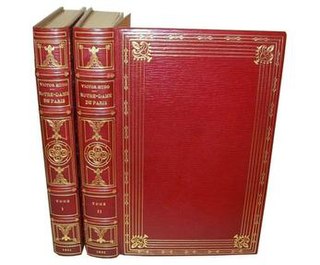
The Hunchback of Notre-Dame is a French Gothic novel by Victor Hugo, published in 1831. The title refers to the Notre-Dame Cathedral, which features prominently throughout the novel. It focuses on the unfortunate story of Quasimodo, the Roma street dancer Esmeralda and Quasimodo's guardian the Archdeacon Claude Frollo in 15th-century Paris. All its elements—the Renaissance setting, impossible love affairs and marginalized characters—make the work a model of the literary themes of Romanticism.
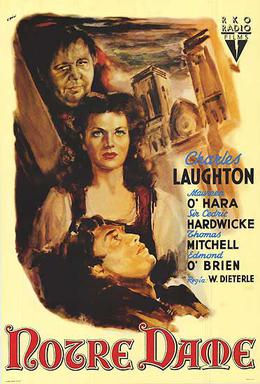
The Hunchback of Notre Dame is a 1939 American romantic drama film starring Charles Laughton and Maureen O'Hara. Directed by William Dieterle and produced by Pandro S. Berman, the film is based on Victor Hugo's 1831 novel. The film is also noted for being the first film ever shown at the Cannes Film Festival before the rest of the festival was cancelled due to the start of World War II.

Quasimodo is a fictional character and the main protagonist of the novel The Hunchback of Notre-Dame (1831) by Victor Hugo. Quasimodo was born with a hunchback and feared by the townspeople as a sort of monster, but he finds sanctuary in an unlikely love that is fulfilled only in death.
Clopin Trouillefou is a fictional character first created in the 1831 novel The Hunchback of Notre-Dame by French author Victor Hugo, and subsequently adapted.

Pierre Gringore was a popular French poet and playwright.
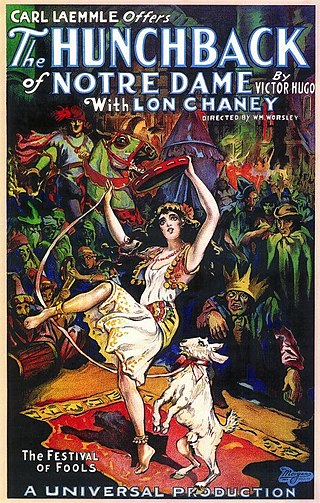
The Hunchback of Notre Dame is a 1923 American drama film starring Lon Chaney, directed by Wallace Worsley, and produced by Carl Laemmle and Irving Thalberg. The supporting cast includes Patsy Ruth Miller, Norman Kerry, Nigel de Brulier, and Brandon Hurst. Distributed by Universal Pictures, the film was the studio's "Super Jewel" of 1923 and was their most successful silent film, grossing $3.5 million. The film premiered on September 2, 1923 at the Astor Theatre in New York, New York, then went into release on September 6.
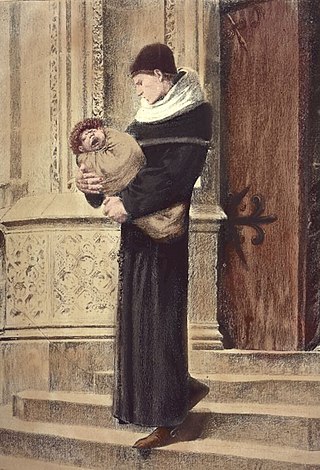
Claude Frollo is a fictional character and the main antagonist of Victor Hugo's 1831 novel The Hunchback of Notre-Dame. He is an alchemist and intellectual, as well as a Catholic clergyman.
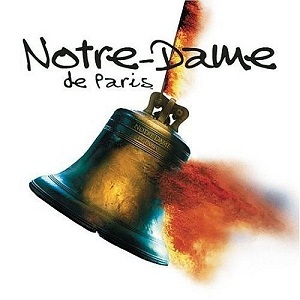
Notre-Dame de Paris is a sung-through French musical which debuted on 16 September 1998 in Paris. It is based upon the novel Notre-Dame de Paris by the French novelist Victor Hugo. The music was composed by Riccardo Cocciante and the lyrics are by Luc Plamondon.

The Hunchback of Notre Dame is a 1956 French-Italian CinemaScope film version of Victor Hugo's 1831 novel, directed by Jean Delannoy and produced by Raymond Hakim and Robert Hakim. It stars American actor Anthony Quinn and Italian actress Gina Lollobrigida. The film is the first version of the novel to be made in color.

The Hunchback of Notre Dame II is a 2002 American animated musical film directed by Bradley Raymond. It is a direct-to-video sequel to Disney's 1996 animated feature film The Hunchback of Notre Dame. The film was produced by the Japanese office of Walt Disney Animation and Walt Disney Television Animation, while it was distributed by Walt Disney Studios Home Entertainment. Much of the actors from the original film reprise their roles, with the addition of new characters played by Jennifer Love Hewitt, Michael McKean and Haley Joel Osment. Critical reception was mostly negative.
La Esmeralda is a ballet in three acts and five scenes, inspired by the 1831 novel Notre-Dame de Paris by Victor Hugo, originally choreographed by Jules Perrot to music by Cesare Pugni, with sets by William Grieve and costumes by Mme. Copère.

Esmeralda, born Agnès, is a fictional character in Victor Hugo's 1831 novel The Hunchback of Notre-Dame. She is a French Roma girl. She constantly attracts men with her seductive dances, and is rarely seen without her clever goat Djali. She is around 16 years old and has a kind and generous heart.

CapitainePhœbus de Châteaupers is a fictional character and the secondary antagonist of Victor Hugo's 1831 novel, Notre-Dame de Paris. He is the Captain of the King Louis XI's Archers. His name comes from Phoebus, the Greek god of the sun.
Judge Claude Frollo is a fictional character and the main antagonist of Disney's 34th animated film, The Hunchback of Notre Dame (1996). He was based on Archdeacon Claude Frollo from Victor Hugo's 1831 novel.
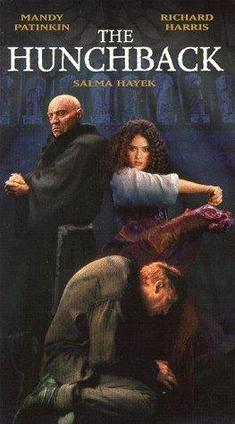
The Hunchback is a 1997 made-for-television romantic drama film based on Victor Hugo's iconic 1831 novel The Hunchback of Notre-Dame, directed by Peter Medak and produced by Stephane Reichel. It stars Richard Harris as Claude Frollo, Salma Hayek as Esmeralda and Mandy Patinkin as Quasimodo, the titular hunchback of Notre Dame.

The Hunchback of Notre Dame was a 1911 French film d'art silent film directed by Albert Capellani and produced by Pathé Frères. It was released under the name Notre-Dame de Paris. It starred Henry Krauss and Stacia Napierkowska. The film was based on the 1831 Victor Hugo novel of the same name. Considering the film's brief running time, critic Christopher Workman considered it "remarkably faithful to its source material" but it "contains no discernible humor, unlike most other horror films of the period, and thus represents a bellwether of sorts for the genre....(Henry Krauss as Quasimodo) "looks remarkably like Charles Ogle in (Thomas) Edison's 1910 Frankenstein."
The Hunchback of Notre Dame is a 1986 Australian/American fantasy animated film and an adaptation of the 1831 novel of the same name by Victor Hugo.

La Esmeralda is a grand opera in four acts composed by Louise Bertin. The libretto was written by Victor Hugo, who had adapted it from his 1831 novel Notre-Dame de Paris. The opera premiered at the Théâtre de l'Académie Royale de Musique in Paris on 14 November 1836 with Cornélie Falcon in the title role. Despite the lavish production, the premiere was a failure, and La Esmeralda proved to be the last opera composed by Bertin, although she lived for another 40 years.
Miss Esmeralda is a Victorian burlesque, in two acts, with music by Meyer Lutz and Robert Martin and a libretto by Fred Leslie, under his pseudonym "A. C. Torr", and Horace Mills. It is based on Victor Hugo's novel Notre Dame de Paris.

Esmeralda is an opera in four acts composed by Arthur Goring Thomas to an English-language libretto by Theo Marzials and Alberto Randegger based on Victor Hugo's 1831 novel The Hunchback of Notre-Dame. It premiered in London on 26 March 1883 at the Theatre Royal, Drury Lane with Georgina Burns in the title role and Barton McGuckin as her lover, Phoebus.